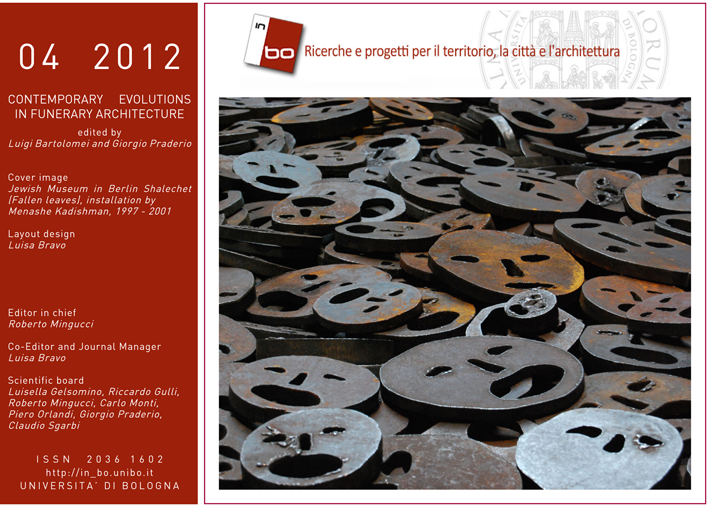Death as a passage. Sacred and archaic in the architecture of Sigurd Lewerentz
DOI:
https://doi.org/10.6092/issn.2036-1602/3249Keywords:
Sigurd Lewerentz, Skogskyrkogården, Chapel of the Resurrection, Stockholm, cemeterial architecture, sacred spaces, landscapeAbstract
In 1915 E.G. Asplund and S. Lewerentz won the Competition for the Enlargement of the South Cemetery in Stockholm. The long and complex series of events leading to the creation of the cemetery in phases began at that point and continued for the whole period of the two architects’ professional activity. When, in 1921, the cemetery authority entrusted Lewerentz with the task of creating the second of the minor chapels - later called the Chapel of Resurrection - the young architect decided to place a classical temple, built of white stone, at the end of the Way of the Seven Wells, the long straight path cut out of the high, dark mass of forest and coming from the Meditation Grove. Lewerentz envisioned a so-called chapel of passage, meaning that the death is not an end point but rather a gateway toward a new dimension.
References
Ahlin, Janne (1985), Sigurd Lewerentz, arkitekt 1885-1975, Byggforlaget, Stockholm
Constant, Caroline (1994), The Woodland Cemetery: Toward a Spiritual Landscape: Erik Gunnar Asplund and Sigurd Lewerentz 1915-61, Byggforlaget, Stockholm
Dymling, Claes (1997) (a cura di), Sigurd Lewerentz, vol. I Photographs of the work, vol. II Drawings, Byggforlaget, Stockholm
Flora, Nicola, Giardiello, Paolo, Postiglione, Gennaro, (2001) (a cura di), Sigurd Lewerentz 1885-1975, Electa, Milano
Johansson, Bengt O.H. (1996), Tallum. Gunnar Asplund’s & Sigurd Lewerentz’s Woodland Cemetery in Stockholm, Byggforlaget, Stockholm
Johnsson, Ulf G. (1964), De första svenska krematorierna och deras förutsättningar, in Konsthistorisk Tidskrift/Journal of Art History, 33 (1)
Markelius, Sven (1926), Uppståndelsekapellet, in Byggmästaren, 20
Nordenström, Hans (1965), Uppståndelkapellet på Skogskyrkogården in Aa.Vv., Hus. 27 arkitekters val ur svensk byggnads konst, Bonniers, Stockholm
Lerup, Lars (1983), Il crematorio di Asplund a Stoccolma, in Lotus International, 38
Lewerentz, Sigurd (1926), Uppgifter rörande Skogskyrkogårdens Uppståndelsekapell med Tillhörande byggnader, in Byggmästaren, 20
Mansilla, Luis Moreno (1987), La Capilla de la Resurreccion, in Aa. Vv., Sigurd Lewerentz. 1885-1975, Dirección General Para la Vivienda y Arquitectura, Madrid
Ortelli, Luca (1990), Sigurd Lewerentz. Architetture inquiete, in Phalaris, 8/9
Porphyrios, Demetri (1983), Classico, cristiano, socialdemocratico. L’architettura funebre di Asplund e Lewerentz, in Lotus International, 38
Smithson, Alison and Peter (1989) Sigurd Lewerentz 1885-1975: The dilemma of Classicism, Architectural Association, London
Vaughan, Hart (1996), Sigurd Lewerentz and the “Half-Open Door”, in Architectural History, 39
Wrede, Stuard (1986), Landscape and Architecture. Classical and vernacular by Asplund, in Caldenby, Claes e Hultin, Olof, Asplund, Arkitektur Förlag, Stockholm
Wilson, Colin St.John (1987), Sigurd Lewerentz and the Dilemma of the Classical, in Perspecta, 24
Downloads
Published
How to Cite
Issue
Section
License
Copyright (c) 2012 Carlotta Torricelli
Copyrights and publishing rights of all the texts on this journal belong to the respective authors without restrictions.
This journal is licensed under a Creative Commons Attribution-NonCommercial 4.0 International License (full legal code).
See also our Open Access Policy.
Metadata
All the metadata of the published material is released in the public domain and may be used by anyone free of charge. This includes references.
Metadata — including references — may be re-used in any medium without prior permission for both not-for-profit and for-profit purposes. We kindly ask users to provide a link to the original metadata record.







